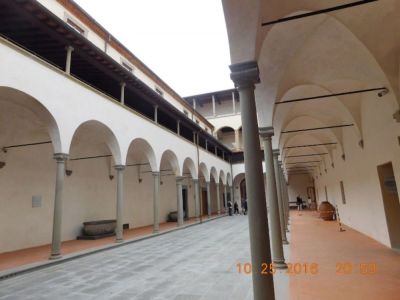Lo Spedale degli Innocenti, oggi Museo degli Innocenti è una delle opere più significative della Firenze quattrocentesca. L’edificio, situato di fronte alla piazza della Santissima Annunziata con la sua loggia, fu progettato da Filippo Brunelleschi nel 1419. Sopraelevato rispetto al livello della piazza da una serie di gradini che percorrevano l’intera lunghezza della facciata, l’ospedale fu costruito in più fasi di cui solo la prima sotto la diretta supervisione dell’artista e quindi completato nel ’36 ed aperto formalmente nel 1445 come primo brefotrofio specializzato d’Europa. Tuttora, nella tradizione di assistenza all’infanzia, la struttura ospita due asili nido, una scuola materna, tre case famiglia destinate all’accoglienza di bambini in affido familiare e madri in difficoltà, ed alcuni uffici di ricerca dell’Unicef. Inoltre, l’Istituto è divenuto Centro nazionale di documentazione e analisi sull’infanzia e l’adolescenza, punto di riferimento nazionale ed europeo per la promozione della cura dei diritti dei più piccoli.
Walking through the Piazza Santissima Annunziata as an exchange student many years ago, the imposing building on the east side of the piazza was never open, but it has proudly kept its long history of service to children.
For over a year, scaffolding and plastic sheathing has promised a renovation that will educate visitors on the buildings’ history. The building, constructed in the 1400s, is regarded as a notable example of early Italian Renaissance architecture. Originally a children’s orphanage, it is now open to the public as a museum. The ospedale innocente tells the story of the children left at the infants’ table (a circular platform that rotated to send the infant to the interior of the building) or older children brought to the ospedale when parents could no longer care for them. Some parents entrusted children to the ospedale until the family might be able to care for them in the future. The children were housed, fed and trained for skilled jobs when they reached maturity. Girls might become nuns or marry since the organization supplied dowries for girls.
Today, three floors are open to view for a small admission fee. On the top floor is a large, glassed wall café with outside seating to enjoy the rooftop views. Off the cloister on the prima piano (first floor) is a large meeting room and many other doors that are not open to visitors. The museum is interactive with audio, videos and text available in English as well as Italian. A headset is an additional fee. You can spend as much time as you wish at each exhibit.
While visiting, we came across a captivating bank of wooden drawers. Each drawer was labeled with a child’s name and a date. Inside is the original item a mother might have left with her child so that identification might be easier when a parent returned to claim their offspring. Opening a drawer from more than 200 or 300 years ago, you find a ribbon or half of a medal (the parent would keep the other half) and other mementos that came to the ospedale with a child. I inspected dozens of boxes, some from the late 1800’s thinking of the mothers who left their children to be cared at the institute. There is a note station nearby where you are asked to leave a message. Videos of several former siblings of children adopted from the ospedale can also be played in English and explained how a family might bring a child from the ospedale home to join their other children. The top floor art gallery houses pieces from very well-known artists. The room is striking from an architectural view point. A large gift shop is located on the first floor and free lockers at the entrances allow you to store handbags and backpacks. There is a small Church within the ospedale open on Sundays for mass.
You could easily spend most of the day reading all the display entries, enjoying lunch in the café and viewing the extensive art exhibit also housed in the buildings all the while letting your mind wander back hundreds of years to Renaissance Florence.
https://www.lagazzettaitaliana.com/travel/8697-ospedale-degli-innocenti-the-hospital-of-the-innocents#sigProId4d4398fa46




